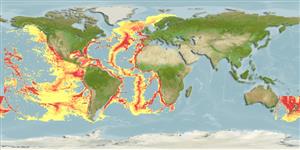Issue
More probably the larvae of a Notacanthus species after Smith (1989: Ref. 93804), of Notacanthus chemitzii Bloch, 1788 after Moser & Charter (1996: Ref. 35578). Confirmation work/publication still needed. Is uncertain in Notacanthidae in Eschmeyer (CofF ver. June 2013: Ref. 93641).
Environment: milieu / climate zone / depth range / distribution range
Ecología
marino batidemersal. Deep-water
Circumglobal: Eastern Pacific: central California to Peru. Western Atlantic: Straits of Florida, Bahamas; Eastern Atlantic: off Gabon; Southwest Pacific: Chatham Islands, New Zealand.
Tamaño / Peso / Age
Maturity: Lm ? range ? - ? cm
Life cycle and mating behavior
Madurez | Reproducción | Puesta | Huevos | Fecundidad | Larva
Oviparous.
Moser, H.G. and S.R. Charter, 1996. Notacanthidae: spinyeels. p. 82-85. In H.G. Moser (ed.) The early stages of fishes in the California Current Region. California Cooperative Oceanic Fisheries Investigations (CalCOFI) Atlas No. 33. 1505 p. (Ref. 35578)
IUCN Red List Status (Ref. 130435)
Threat to humans
Harmless
Human uses
Más información
Age/SizeCrecimientoLength-weightLength-lengthLength-frequenciesMorfometríaMorfologíaLarvaDinámica larvariaReclutamientoAbundanciaBRUVS
ReferenciasAcuiculturaPerfil de acuiculturaRazasGenéticaElectrophoresesheritabilidadEnfermedadesProcesamientoNutrientsMass conversion
ColaboradoresImágenesStamps, Coins Misc.SonidosCiguateraVelocidadTipo de nataciónSuperficie branquialOtolitosCerebrosVisión
Herramientas
Special reports
Download XML
Fuentes de Internet
Estimates based on models
Preferred temperature (Ref.
123201): 2.8 - 8.2, mean 4.3 °C (based on 1093 cells).
Phylogenetic diversity index (Ref.
82804): PD
50 = No PD50 data [Uniqueness, from 0.5 = low to 2.0 = high].
Bayesian length-weight: a=0.00102 (0.00046 - 0.00225), b=3.06 (2.88 - 3.24), in cm total length, based on all LWR estimates for this body shape (Ref.
93245).
Nivel trófico (Ref.
69278): 3.4 ±0.4 se; based on size and trophs of closest relatives
Resiliencia (Ref.
120179): Muy bajo, población duplicada en un tiempo mínimo superior a 14 años (Preliminary K or Fecundity.).
Fishing Vulnerability (Ref.
59153): Moderate vulnerability (42 of 100).
